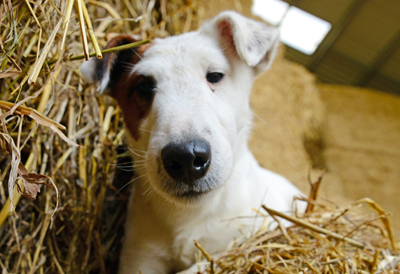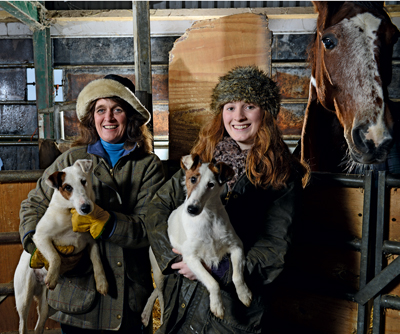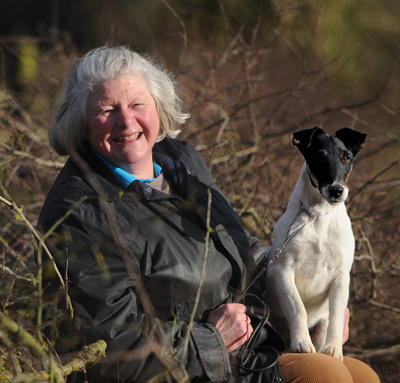Save the smooth fox terrier
Mattthew Dennison says the smooth fox terrier is a treasured breed in crisis


In the summer of 2010, a piece of taxidermy caused a stir among Antiques Roadshow experts filming in Cumbria. The specimen was a dog. Predominantly white, with darker markings on its face, it was presented in a glass case, crouching on a velvet cushion, poised as if to spring, still apparently as alert and lively as the day it died in 1894.
The dog was a smooth fox terrier, which had once belonged to the man known as ‘England's greatest sporting gentleman', the 5th Earl of Lonsdale. Experts identified it as the oldest traceable example of this breed of English working dog, first officially recognised by the Kennel Club (KC) in the 1870s. Even after a century, the long-dead dog suggested to the viewer the boundless energy of the working terrier, its quick intelligence and warm, affectionate nature that continues to endear.

It is, however, a breed in crisis. Over the past decade, annual KC registrations have only once exceeded 200 and, in 2012, only 94 puppies were registered (compared with more than 36,000 labrador puppies). Like many native breeds developed for working or sporting purposes, these resilient dogs, described by one owner as ‘tough little nuts', are victims of changing canine fashion. ‘It's not fashionable to be on the end of a terrier's lead,' says owner Joanna Darby. ‘Very sadly, there just aren't the smooth fox terriers out there anymore for people to come across. People say "My grandfather had one", but they don't themselves have smooths.'
Rose Marston is an exception. Her grandfather, Capt Philip FitzGeorge-Parker, was a well-known breeder and, 10 years ago, Mrs Marston decided to acquire her own dogs. She currently has six: two live with her family in their Northamptonshire farmhouse, two live inside during the winter and two in kennels outside. ‘They are extremely healthy dogs, completely problem-free. I will always have them now,' she states. ‘They're brilliant with children and wonderful fun. Smooth fox terriers are dogs that are never bored and so they're never boring. They want to enter into whatever you're doing and they constantly find ways of amusing themselves, which, in the case of mine, is by looking for rabbits.'

Rose Marston and her daughter fleur have a number of smooth fox terriers
Boundless activity is among the many characteristics of these handsome little dogs. Formerly used to bolt foxes, they are capable of impressive speed and possess the stamina and appetite for as much energetic activity as their living conditions permit. ‘Unless a smooth fox terrier is going at 100 miles an hour, that smooth fox terrier is unwell,' Miss Darby remarks. City-dwellers need to ensure their dogs have two walks a day-and that the dog is attached to a lead, if there is any chance of an encounter with a cat.
Although all owners agree that fox terriers are eminently manageable, it's undoubtedly the case that a glimpse of a cat stimulates atavistic hunting instincts. Former competitive rider Mary Crouch, who acquired Henry, the first of her four smooth fox terriers, nine years ago, laughs: ‘Henry has only one thing on his mind-it's called hunting!'
Exquisite houses, the beauty of Nature, and how to get the most from your life, straight to your inbox.
This classic terrier trait could suggest grounds for the breed's current fall from popularity, were it not for their intelligence. ‘They're so bright,' Miss Darby tells me. ‘Even when they're being hopelessly naughty, they're biddable, because they know that they've been naughty and you can teach them.' Mrs Marston points to the frequency with which she spies a terrier emerging from the stables, having plucked one of the horses' carrots from the nets. It's a harmless transgression.
Good training, owners agree, usually easily corrects more serious offences. Mrs Marston was recently asked to lend one of her terriers, Gemstone, to a glossy magazine for a photo shoot. ‘They wanted the dog to sit. I had never taught my dogs to sit. As it happened, she learnt in about one second and acquitted herself beautifully.' Gemstone's performance contrasts with that of Mrs Crouch's Henry, who, on one occasion, spent his time in the showring either sitting down or sleeping.

Mrs Crouch works her terriers from time to time
Mrs Crouch cheerfully admits that her four smooth fox terriers are ‘thoroughly spoilt': they live in old stone stables, with heating, lamps and even televisions. They spend their mornings outside in a well-fenced 1.5 acres and, mindful of their sporting heritage, Mrs Crouch works them from time to time. However, they don't spend too much time in the garden. As the Smooth Fox Terrier Association (www.smoothfoxterrierassociation.co.uk) cautions: ‘Smooths are natural-born gardeners and will enjoy helping you to dig, especially when you are planting. As soon as your plants are in the ground, he'll take them out again and give them back to you-or run off with your tools.'

Dogs are in Miss Darby's blood. Her parents, who met at a dog show in 1954, bred terriers and cocker spaniels throughout nearly 60 years of marriage; Miss Darby also breeds cockers. Yet, in more than 30 years as a smooth fox terrier owner, a single dog stands out.
He's one of her current pack, Barnaby, a well-known 10-year-old former champion of classic appearance and conformation. However, what Miss Darby loves most is Barnaby's nature: he once spent 18 months in Italy with 30 other dogs, but the moment he heard his owner's voice, quietly in conversation with the Italian kennel owner, he returned to her side instantly. ‘They never forget somebody who has been kind to them. They're sometimes show-offs, they're witty and clever, but, most of all, they're very affectionate.' Taking the rough with the smooth
Smooth operators
Smooth fox terriers are medium-size dogs, likened in the breed standard to a short-backed, well-made hunter, able to cover a lot of ground. In origin, they probably share ancestry with the progenitors of Manchester terriers (the black-and-tan terrier) and the bull terrier. Properly trained, they're suitable for town and country. However, these dogs thrive on exercise, the main reason for their surprisingly big appetites. Their short, white coats require minimal daily brushing. Friendly by nature, they're alert, with excellent hearing and a big bark, and make first-rate guard dogs. The smooth fox terrier's lifespan is usually between 12 and 15 years.
A bit of rough
The origins of the wire fox terrier-the smooth's bearded, shaggy cousin-are difficult to trace precisely. However, 16th-century paintings depict small, rough-coated terriers, with the familiar markings, and, in his 1677 treatise The Gentleman's Recreation, Nicholas Cox states that there are two sorts of terriers-one with legs more or less crooked and with short coats and the other straighter in the leg and with long jackets.
The wire fox terrier's pluck has led to it being cast in heroic roles-Snowy, Tintin's canine companion, is one and, in 1934, the breed's profile was given a boost by Asta's scene-stealing performance in The Thin Man. Not so much heroic as despotic was Thomas Hardy's Wessex-the dog was famous for shredding guests' trouser legs. Thankfully, he was an exception-the KC describes the breed as ‘cheerful and happy' and ‘an excellent children's playmate and family pet'.
Photographs by John Millar
* Follow Country Life on Twitter
Country Life is unlike any other magazine: the only glossy weekly on the newsstand and the only magazine that has been guest-edited by His Majesty The King not once, but twice. It is a celebration of modern rural life and all its diverse joys and pleasures — that was first published in Queen Victoria's Diamond Jubilee year. Our eclectic mixture of witty and informative content — from the most up-to-date property news and commentary and a coveted glimpse inside some of the UK's best houses and gardens, to gardening, the arts and interior design, written by experts in their field — still cannot be found in print or online, anywhere else.
